If you’ve been hanging about a bit on Needle ‘n Thread for a while, you probably know that ecclesiastical embroidery is kind of a Thing of mine. It’s what originally pulled me into taking embroidery seriously as an art and led me into learning different techniques.
Ever since my first infatuation with ecclesiastical embroidery – especially historical examples of it – I’ve been collecting old embroideries and old pattern folios.
I think the pattern folios are pretty fascinating! They’re large envelopes or board covers (often tied together with ribbon) filled with massive fold-out sheets of patterns.
The patterns themselves are ingeniously arranged, so that there’s no wasted space in the printing. Often, when patterns are meant to be repeated or substitutions can be made, letters and lines indicate the connections and suitable substitutions. Looking at these old pattern pages – and using them! – is kind of like putting together a puzzle.
Today, I’ll show you some examples of typical pattern pages and how the designer gets as much use out of space as possible. We’ll also talk a little bit about symbolism, and I’ll share a pattern from an old portfolio that’s cleaned up and user-friendly.
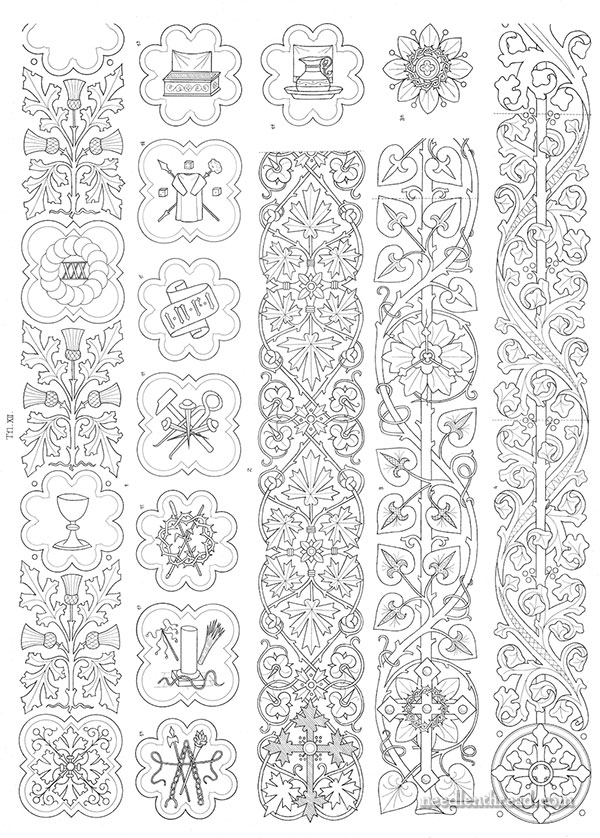
This is a scan of part of an original pattern page, already a little cleaned up. The page itself is old and yellow, but the designs are crisp and clear, perfectly usable.
In real life, the excerpt above prints at about 17″ x 22″.
The page features several bands that could be repeated to whatever length is needed for embellishing ecclesiastical vestments, linens, or other furnishings.
The small medallions on the page are interchangeable with the medallions in the band on the left.
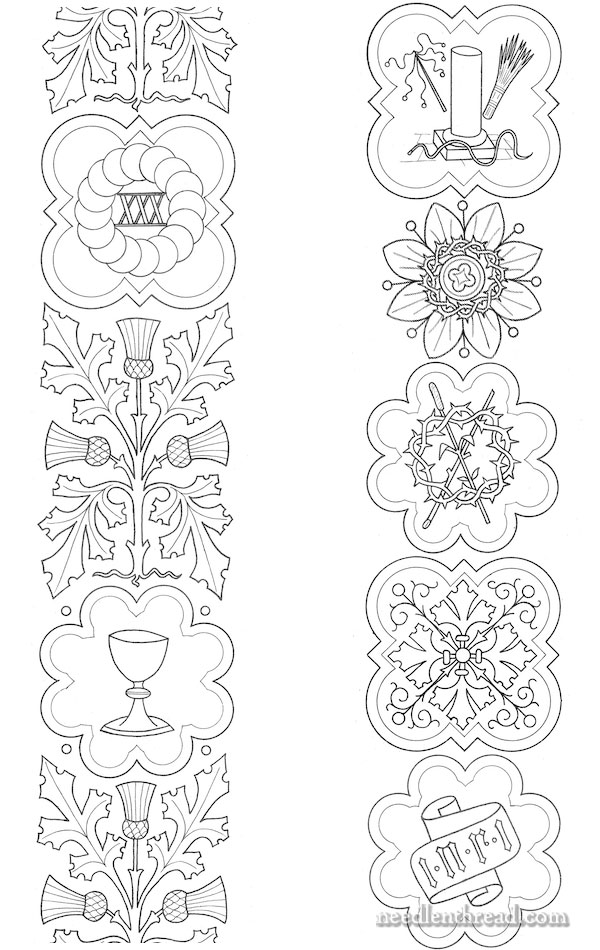
Any of the medallions – or the passion flower – on the right can be substituted for the medallions already in the band on the left. If the embroidered band is going to be particularly long, then the medallions can be used along the length of it, without any repeats in the symbols.
Symbolism is very important in ecclesiastical embroidery. Designers don’t just mash things together without taking into consideration their meaning. Each medallion, then, is symbolic of something, as is the entire embroidery.
Notice that the design band on the left features thistles. (You can find the individual thistle design to download and use, here.)
In Christian symbolism, thistles are associated with the passion and death of Jesus Christ (the thorns being representative of the crown of thorns).
An ecclesiastical embroidery designer, then, would only make use of that particular design band on pieces meant to be used during penitential times of the liturgical year (such as Lent or Advent, certain vigils, and the like).
The embroiderer would be careful to choose appropriate medallions to embroider along the band. The symbols inside the medallions would coordinate with the overall message, based on the overriding thistle theme. So symbols associated with the passion and death of Christ would be appropriate, but symbols associated with the Resurrection of Christ or with the Blessed Virgin Mary, or with other joyful associations, would not be appropriate.
For example, you wouldn’t see, along this thistle band, roses, lilies, sunrises, or the Agnus Dei symbol with the lamb standing and the banner completely unfurled. But you might see passion flowers, symbols of the passion (like the medallions shown above), sacred monograms representing Christ, a pelican, or the Agnus Dei with the lamb recumbent, or lying down, with the banner partially or completely furled.
The color of the vestment or furnishings for this design would most likely be predominantly violet, or, if they’re for Good Friday, they could be black.
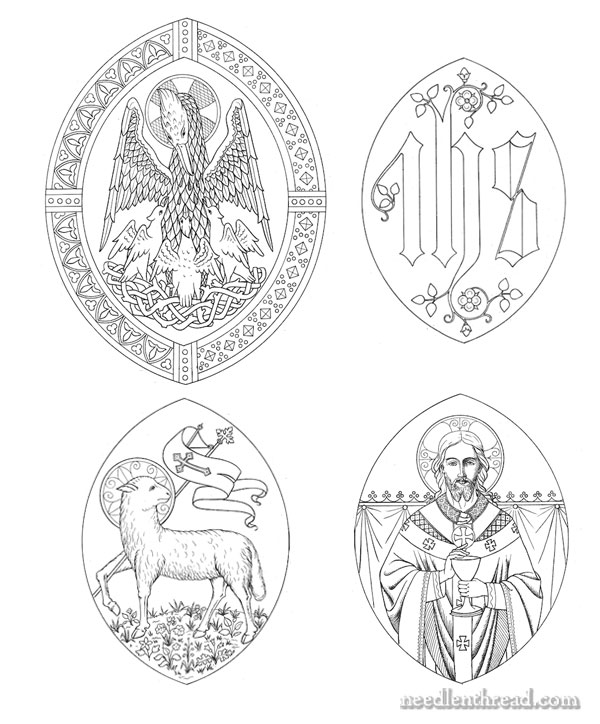
Here’s another example of some excerpts from a pattern folio.
These particular excerpts were not on the same page, but they’re numbered so that the embroiderer knows that there’s an association between the framed design (top left), and these other marquise-shaped designs that are found, here and there, throughout the folio.
The frame around the pelican on the left looks a bit odd, doesn’t it? It has one design running down the left side, and a completely different design running down the right.
As you can guess, this allows the embroiderer some options on the frame!
The marquise-shaped designs, as you can also guess, fit within that frame.
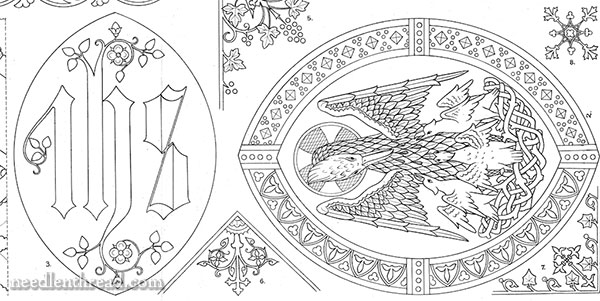
This is a clip of the original layout in the folio, featuring two of the associated designs. The other two were on a separate folio page.
If you mix and match the two frame options with the different center designs, you essentially get eight possible complete designs, all in the space of four!
Throughout the folio, there are other designs that could fit into that frame as well by enlarging or reducing the designs, but the four designs above – the pelican, the sacred monogram, the Agnus Dei, and Christ the High Priest – all fit perfectly within the frame, without making any adjustments to the designs.
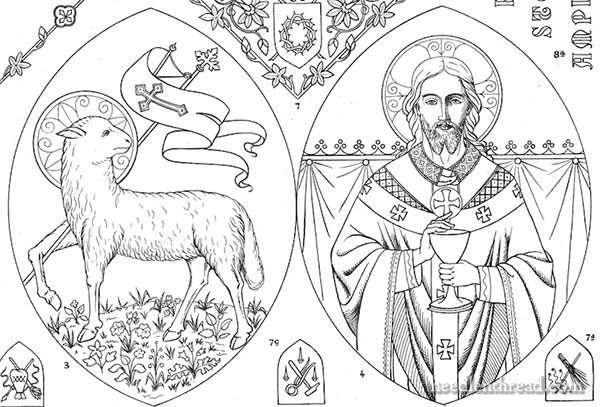
Incidentally, see the tiny little badges at the base of the images above? They can be swapped out for that little badge in the foliage that situated between the two marquise-shaped designs.
Between larger elements throughout the whole folio, you’ll find heaps of little individual elements that can be used in isolation, repeated, or connected and incorporated with other larger designs throughout the folio.
The designers behind these old folios were pretty ingenious when it came to using space in their layouts and offering as many design options to the embroiderer as possible.
Free Ecclesiastical Embroidery Pattern
Here’s one of those options, combining one frame style with the IHS sacred monogram.
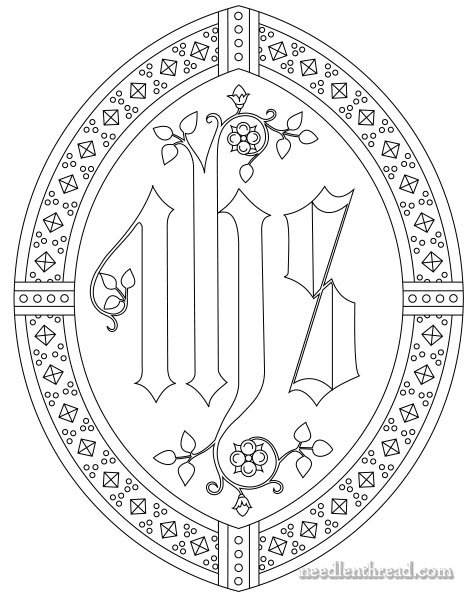
The frame would be beautiful in goldwork with pearls and jewels set in where indicated.
At the time this folio was produced, though, it would be more likely that the designer figured the embellishments would be stitched with silks in satin stitch, in vibrant colors to represent jewels.
Here’s the PDF printable:
IHS Sacred Monogram in Jeweled Frame
The design prints at 7″ high, making it appropriate for the back of a vestment, but it can be reduced or enlarged for other uses as well.
Looking for More Ecclesiastical Embroidery?
You’ll find all the ecclesiastical embroidery articles on Needle ‘n Thread here.
You can also find several more free church embroidery patterns available here.
And if you’re looking for even more patterns, you might be interested in my Church Embroidery Patterns e-book, available here.
Enjoy your weekend!







Hi, Mary,
I have been looking for ecclesiastical designs recently, so this post is most welcome!
Most, or perhaps all, designs pertain to the liturgical year. Do you know of any designs that pertain to the teachings of Jesus concerning care for the poor and sick?
I am working with the passage from Mt 25 about the hungry, thirsty, & naked that leads up to, “Inasmuch as ye have done it unto one of the least of these my brethren, ye have done it unto me.”
Thanks,
Beth
.
Those are all so beautiful. Many of the medallions I’ve seen in our own church. It makes sense to use various medallions for the many church seasons. Do you know if anyone has done one long banner or wall hanging using them all depicting the complete life of Christ? Wouldn’t that be something to see?
WOW…what an interesting and informative post!!! This is not my area of interest and I wouldn’t even know where to begin stitching these gorgeous patterns, but the information is fascinating!! You’re right, those designers were very ingenious. Thanks for the great history lesson.
I grew up in the Methodist faith, and those patterns look very familiar, it we also had a color seasonality thing, too. White is for Christmas and Easter. But today…the only day of the year….is black. Purple is right before Christmas.
Altar cloths and the scarfy thing the minister wore matched.
Happy Easter!!
These are superb – thank you very much Mary.
I love all of these, and you have both enriched and inspired my Good Friday this year. Thank you and Happy Easter.
Thank you Mary!
The designs and layout of these patterns are as interesting and attractive as the resulting embroidery – a feature I’ve noticed in several of Mary’s reviews of “products.”
This information is so interesting. Thank you for sharing your knowledge. I purchased your Church Embroidery Patterns e-book a while back. I have enjoyed browsing through it and one day soon I hope actually try stitching one of the designs.
Thanks for sharing these beautiful patterns, Mary. Just a thought, could that pelican possibly be a phoenix? It looks as though it is plucking at its own breast to feed its blood to the young ones. Blessings and peace.
It’s a pelican. Back in the day, it was thought that the pelican pierced its breast to feed its young. And that’s how the symbol emerged, from that notion.
I would love to get the pelican design!! Any plans to clean it up for download?
Eventually, yes! 🙂
It’s always interesting to see how old patterns were produced. And thanks for the info on the symbolism. Ecclesiastical embroidery is not a subject I have explored very much, so it is very interesting to hear about it from someone who has a passion for it.
Hi Mary Corbet,
I used your pattern as a basis for an embroidery project.
https://www.pinterest.com/pin/320388960983149234/
Really appreciate your work. I use the Church Patterns book all the time!
Thanks!
So beautiful, Melissa! I shared it on Pinterest and Facebook – it’s just lovely. Your satin stitch is …. *sigh*… gorgeous!